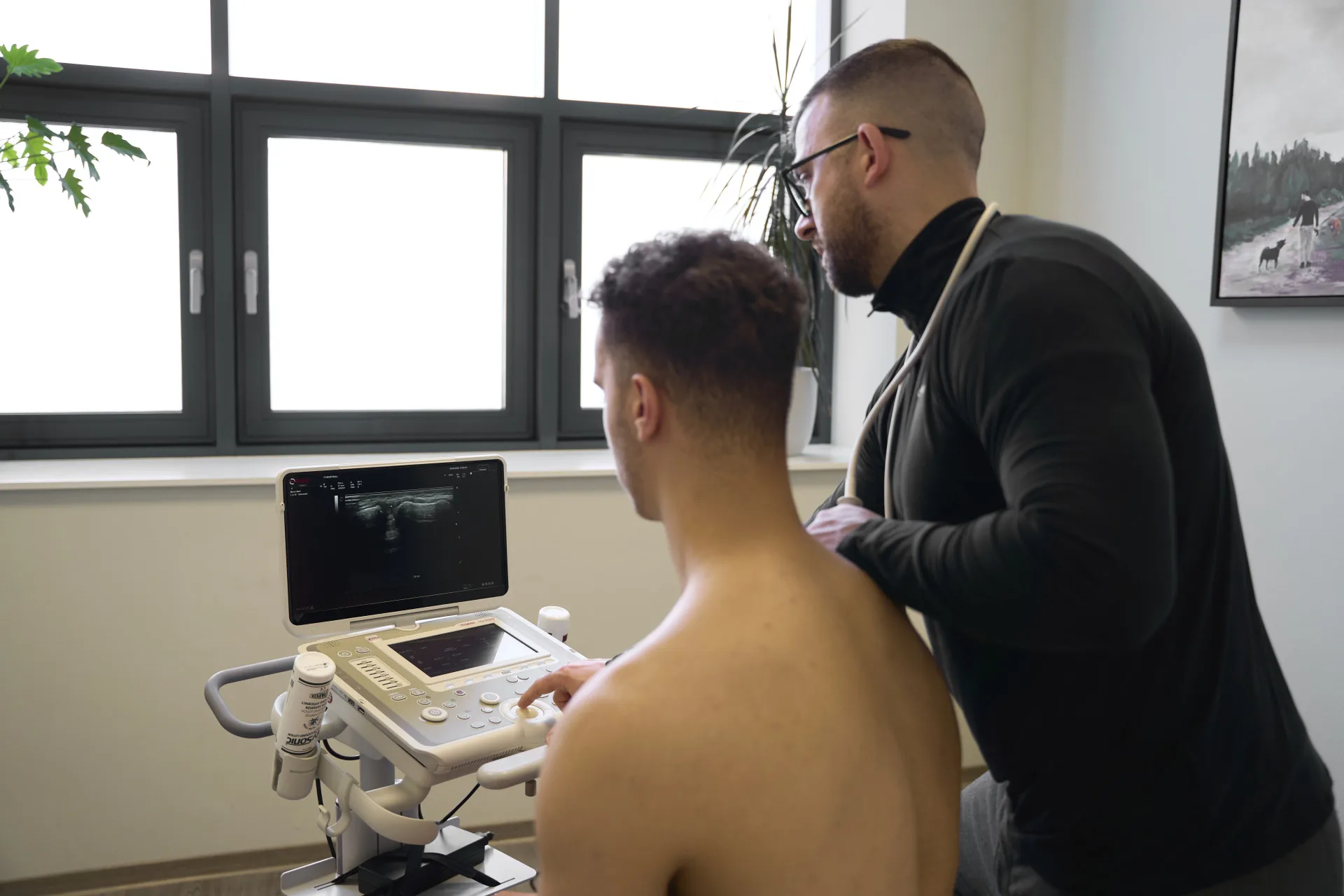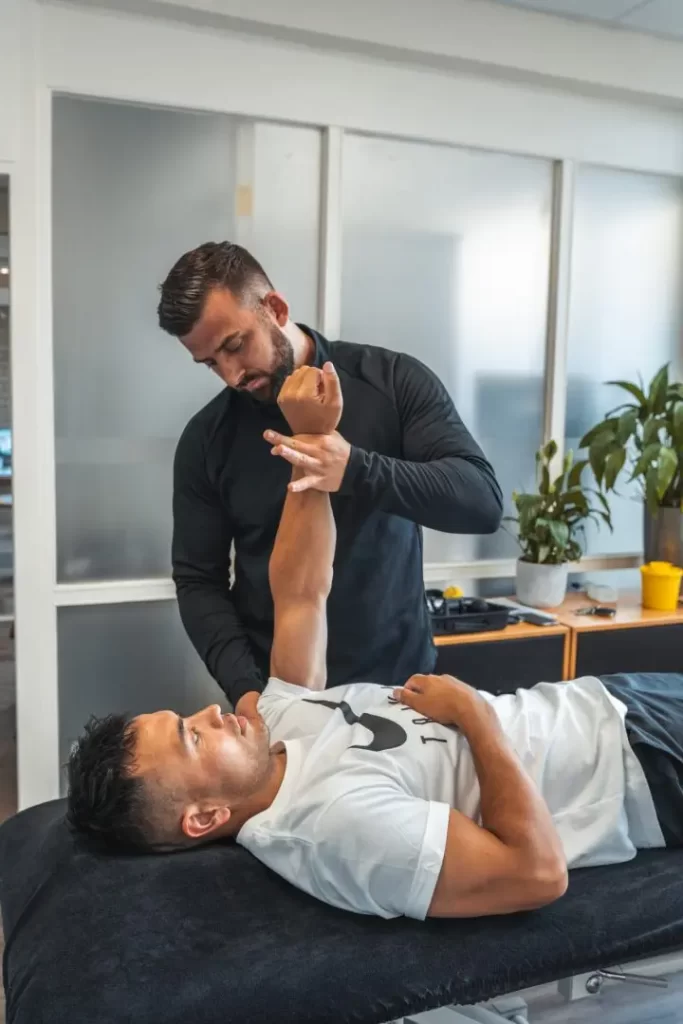Shoulder pain
Do you suffer from shoulder pain and are looking for a quick, sports-oriented approach in Tilburg? Our specialised sports physiotherapists combine years of experience with ultrasound examination to identify the cause of your shoulder pain quickly and effectively. Whether you are an avid athlete or just suffer from long-term discomfort with everyday movements - we will help you get back to pain-free movement with a targeted treatment plan.

Cause
The shoulder is a joint with very high mobility by nature. Precisely because of this great range of motion, the joint is prone to overuse, instability or injury. Muscles, tendons and the capsule of the shoulder have to function properly to transfer forces. Shoulder problems in athletes are often caused by repeated, forceful movements or peak loads, for example during strength training, martial arts or ball sports such as handball, volleyball or tennis.
Of course, a fall on the shoulder can also cause symptoms, which we call traumatic shoulder pain. Athletes who work with high weights, explosive arm movements or repeated shoulder rotations are at extra risk of overuse or even structural damage.
Common causes of sports-related shoulder problems are irritation of the tendons, such as at the rotator cuff, instability problems or (sub)luxations. Other complaints we regularly see in practice include: SLAP lesions, bursitis (bursitis) and calcifications in the tendons (calcifications). At Fysio Fitaal in Tilburg, we focus on a thorough analysis of both the complaint and the underlying movement problem. This is how we arrive at an effective and sports-oriented approach.
Common Shoulder pain

Cuff rupture in the shoulder
Do you have pain, loss of strength or difficulty lifting your arm? Then the...

Musculus pectoralis minor (the small pectoral muscle)
Symptoms that occur with complaints of the pectoralis minor muscle are pain in the chest...

Biceps tendon rupture
Tearing of the biceps tendon usually happens while the biceps is applying too much sudden force...


Subacrominial pain syndrome (SAPS)
Complaints occur when lifting or turning the arm inward/outward and the...

Shoulder luxation (dislocation)
A shoulder luxation is usually caused by a hard fall and is often accompanied by pain ...

Rotator cuff rupture
A rotator cuff rupture is a tear in one of the tendons that support the shoulder joint....

Frozen shoulder
Frozen shoulder, also known as frozen shoulder or adhesive capsulitis, is a condition of the...

Deltoid tendinopathy
A deltoid tendinopathy occurs due to reduction in quality of tendon tissue.
Risk factors
Many people only realise afterwards that daily activities, sports habits or workload have contributed to the onset of shoulder pain. For instance, repeated movements above shoulder height or prolonged loading in one position can cause symptoms. Also consider athletes who regularly move heavy weights, such as when bench pressing or people active in martial arts where explosive arm movements are frequent. Occupations with a lot of repetitive arm movements, such as painting or plastering, can eventually lead to complaints. We also see that people with a lot of unilateral loading - such as tennis players or throwers - are more likely to develop shoulder problems.
By becoming aware of these factors, you can intervene in time or take preventive measures. Our therapists will help you with a clear intake, movement analysis and - if necessary - additional ultrasound examination.
Ultrasound for shoulder pain
At Fysio Fitaal in Tilburg, we use ultrasound to get a quick and reliable insight into the cause of your shoulder pain. This examination is pain-free, safe and without waiting time. Within 20 to 30 minutes you will have clarity - accessible without a doctor's referral.
Ultrasound allows us to visualise structures such as tendons, bursas, muscle attachments and calcium deposits. Thanks to this instant insight, you get appropriate advice and we can treat in a targeted way or also indicate when another care pathway is necessary.
This way, we ensure a quick start to your recovery process, with clear explanations and personal advice. By combining sports physiotherapy and ultrasound, we offer a unique total package for anyone with shoulder problems in Tilburg.
Different types of shoulder injuries
At Fysio Fitaal, we see a variety of shoulder complaints on a daily basis. One of the most common complaints is Subacromial pain syndrome (SAPS), a collective term for pain on the outside of the shoulder, often when lifting the arm. This may be related to tendon irritation, bursitis or calcification of the tendons, but without obvious irritation of a specific structure. Also rotator cuff injury is common - ranging from mild irritation to a partial or complete tear of the tendons that provide strength and stability in the shoulder.
In addition, we regularly cover instability complaints, in which the shoulder is too mobile and easily dislocates (luxation or subluxation). SLAP lesions (damage to the cartilage ring in the shoulder) are especially common in throwing and strength athletes. Finally, bursitis (inflammation of the bursa) and calcifications (calcification in tendons) common diagnoses associated with pain, stiffness and loss of function.
Anatomy and function of the shoulder
The shoulder joint consists of the humerus(upper arm bone), scapula(shoulder blade) and clavicle(collarbone). The joint between the upper arm and shoulder blade is called the glenohumeral joint. The clavicle with the shoulder blade is the acromioclavicular joint. Another joint of the shoulder region is the scapulothoracic joint. This is the joint between the shoulder blade and the ribs. These joints allow the shoulder to move in many different directions. The shoulder contains many different muscles and tendons. The function of these muscles is to move and stabilise the shoulder during various daily movements. There are smaller muscles that are closer to the joint but also larger muscles that have a more powerful function. Anatomically, a distinction is made between a local muscle system and a global muscle system. Functionally, however, they largely have the same function. In a non-restricted shoulder, the glenohumeral capsule, the capsule around the glenohumeral joint is stretchable, long and does not restrict the shoulder's normal range of motion. The function of this capsule is to provide strength in the shoulder. In frozen shoulder, the capsule of the glenohumeral joint tightens due to an inflammatory reaction. This limits the range of motion of the shoulder. There may also be a decrease in synovial fluid in the joint. This synovial fluid, also known as joint fluid, allows joint surfaces to move smoothly in relation to each other by minimising friction.
Physiotherapy for shoulder pain
During the examination, we will look at the possible cause of your shoulder pain. Based on the examination, a clear treatment plan will be drawn up. Keep moving with shoulder complaints is very important to maintain the mobility in the shoulder. Besides specific advice, treatment can include: restoring mobility through manual therapy, dry needling, various muscle techniques and training the muscles of the upper back and shoulder through exercise therapy.
The different type x injuries
The different type x injuries
Physical testing
Physical testing
Making an appointment at FysioFitaal
We work from multiple locations in Tilburg, always close by for professional and accessible physiotherapy. Fill in the contact form and we will contact you soon. Together, we will work on your recovery!

